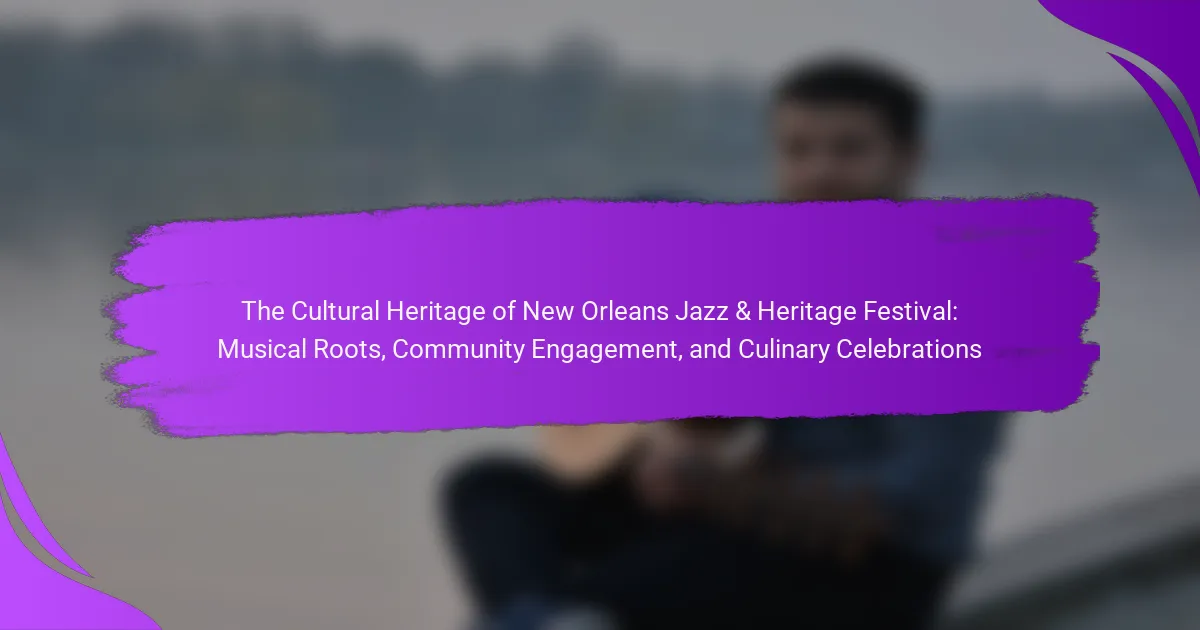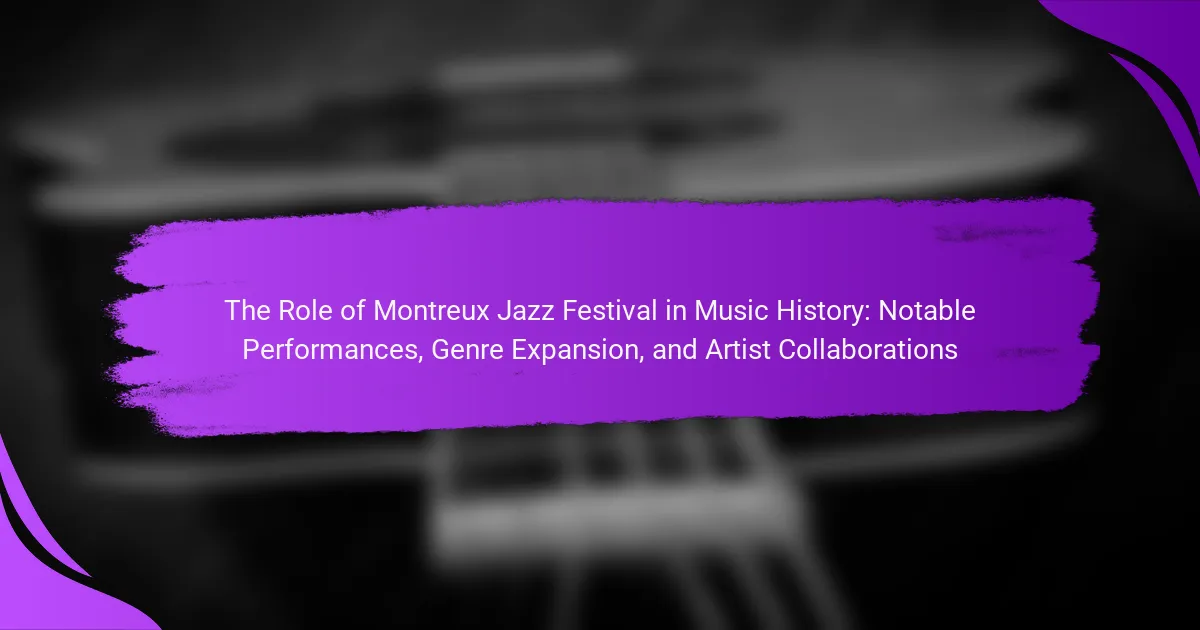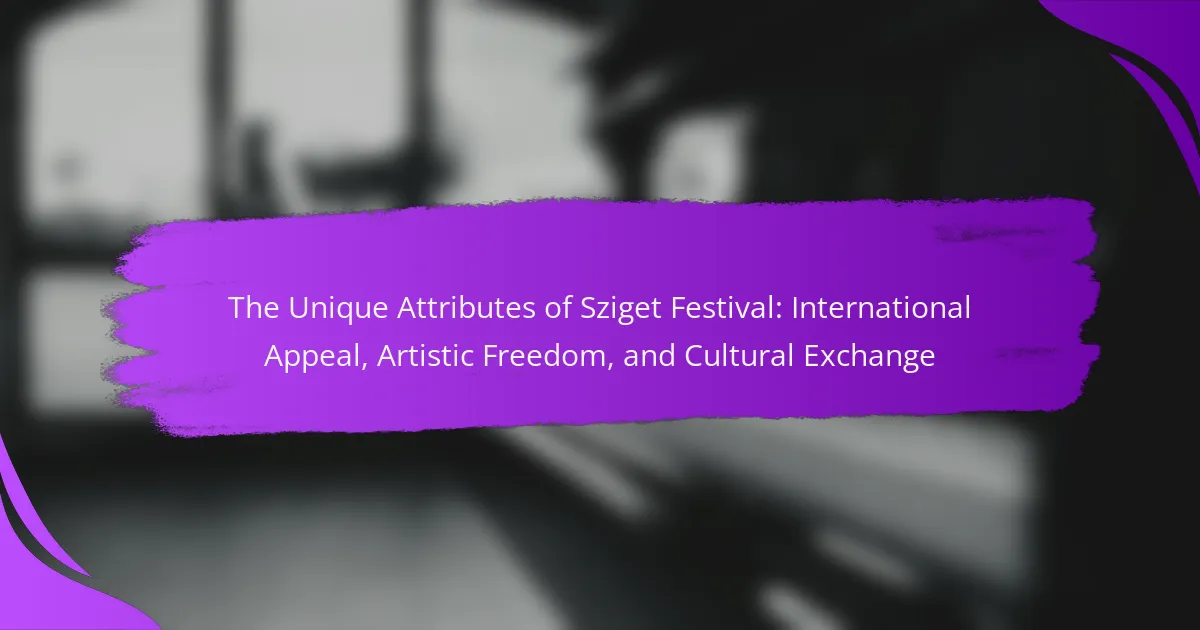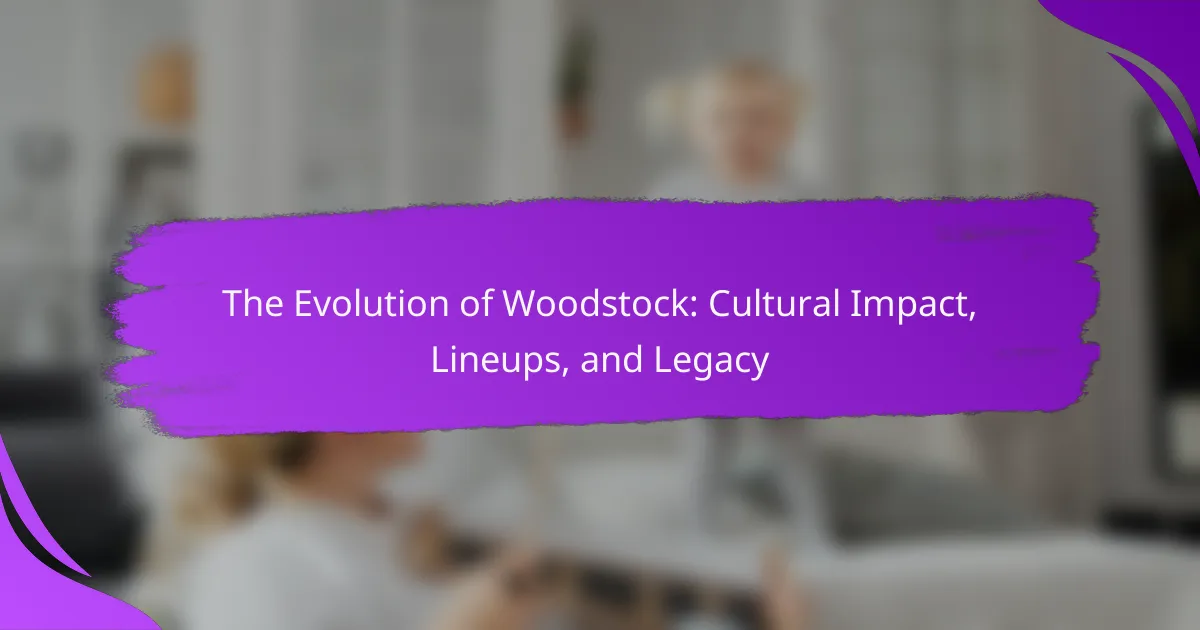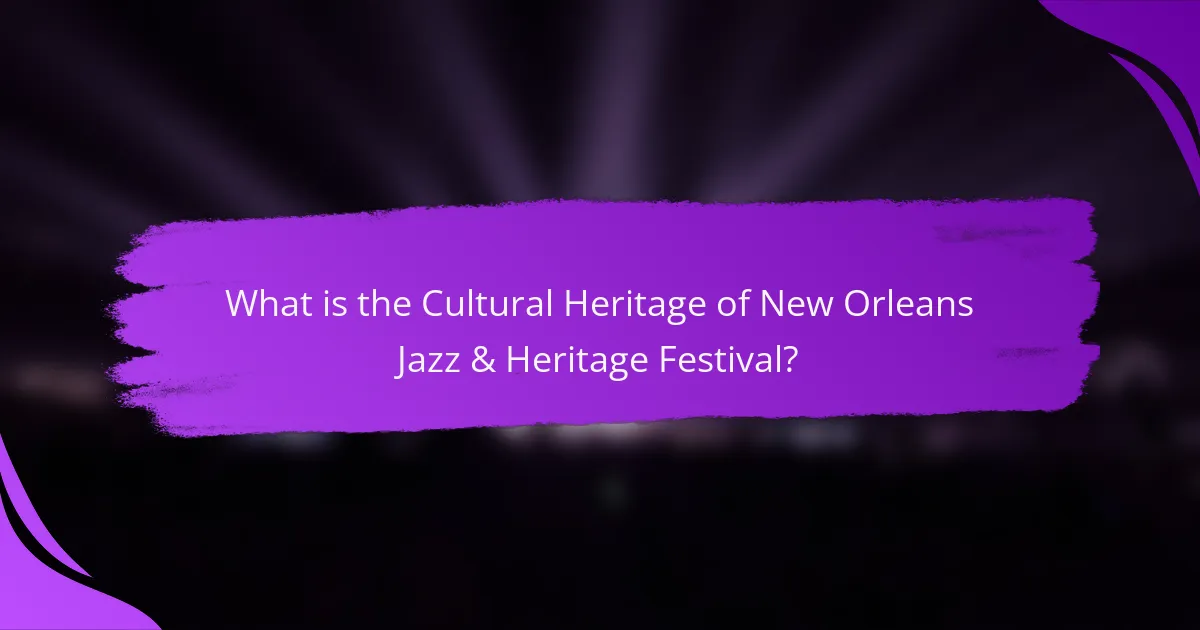
What is the Cultural Heritage of New Orleans Jazz & Heritage Festival?
The Cultural Heritage of New Orleans Jazz & Heritage Festival celebrates the city’s rich musical and cultural traditions. This festival showcases diverse genres including jazz, blues, and gospel. It emphasizes the historical significance of African American culture in New Orleans. The event features local artists and musicians, highlighting their contributions to the music scene. Culinary offerings at the festival reflect the city’s unique Creole and Cajun cuisines. The festival also promotes community engagement through workshops and educational programs. It has become a platform for preserving and sharing cultural heritage. Since its inception in 1970, the festival has attracted millions of attendees, reinforcing its importance to the cultural landscape.
How did the Jazz & Heritage Festival originate?
The Jazz & Heritage Festival originated in 1970 as a celebration of New Orleans’ unique culture and music. It was founded to promote the city’s rich musical heritage, particularly jazz. The festival aimed to showcase local artists and attract tourism. It was initially a one-day event but quickly expanded due to its popularity. The festival highlights various music genres and cultural traditions. It also features local cuisine, arts, and crafts. Over the years, it has grown into one of the largest music festivals in the United States. The festival reflects the diverse cultural landscape of New Orleans.
What were the historical influences that shaped the festival?
The historical influences that shaped the New Orleans Jazz & Heritage Festival include the city’s rich musical heritage and diverse cultural traditions. The festival emerged in 1970, reflecting the blend of African, French, Spanish, and Creole cultures. Influential musical genres such as jazz, blues, and gospel played a significant role in its development. The festival was designed to celebrate and preserve this unique cultural identity. Additionally, the civil rights movement of the 1960s emphasized the importance of African American culture, which influenced the festival’s focus on community engagement. The incorporation of local cuisine highlights the culinary traditions that are integral to New Orleans’ culture. These historical factors collectively contributed to the festival’s establishment as a celebration of music, culture, and community.
Who were the key figures in the festival’s establishment?
The key figures in the establishment of the New Orleans Jazz & Heritage Festival include George Wein and the founders of the New Orleans Jazz and Heritage Foundation. George Wein was a prominent jazz promoter and festival organizer. He played a crucial role in creating the festival in 1970. The festival aimed to celebrate the music and culture of New Orleans. The New Orleans Jazz and Heritage Foundation was established to support local musicians and cultural programs. These figures were instrumental in shaping the festival’s vision and mission. Their contributions helped establish the festival as a significant cultural event in New Orleans.
What role does music play in the festival’s cultural heritage?
Music serves as a vital expression of cultural heritage at the festival. It reflects the historical roots of New Orleans, showcasing genres like jazz, blues, and zydeco. These musical styles connect attendees to the city’s diverse cultural influences. The festival features performances that celebrate local artists and traditions. This fosters community pride and engagement among participants. Furthermore, music acts as a medium for storytelling, conveying the experiences and struggles of the local population. Through workshops and educational programs, the festival preserves and promotes musical knowledge. Overall, music is integral to the festival’s identity and cultural significance.
What genres of music are featured at the festival?
The festival features genres such as jazz, blues, R&B, gospel, and Cajun music. Each genre reflects the rich cultural heritage of New Orleans. Jazz is the festival’s primary focus, celebrating its historical significance. Blues and R&B showcase the city’s influence on these styles. Gospel music adds spiritual depth to the lineup. Cajun music represents the unique cultural blend of the region. The festival also includes rock, funk, and hip-hop, highlighting its diverse musical landscape. This variety attracts a wide audience, emphasizing community engagement and cultural celebration.
How do local musicians contribute to the festival’s identity?
Local musicians shape the festival’s identity through their unique cultural expressions. They bring authentic sounds and styles rooted in the community. Their performances reflect the rich musical heritage of New Orleans. This authenticity attracts both locals and tourists, enhancing the festival’s appeal. Local musicians often collaborate with each other, fostering a sense of community. Their participation showcases diverse genres, from jazz to blues and beyond. This variety enriches the festival experience for attendees. Overall, local musicians are integral to the festival’s cultural narrative and vibrancy.
What is the significance of community engagement at the festival?
Community engagement at the festival is significant because it fosters local pride and cultural identity. It encourages participation from diverse community members, strengthening social bonds. Engaging the community enhances the festival’s authenticity, showcasing local talent and traditions. This involvement attracts visitors and boosts the local economy. Studies show that festivals with strong community ties see higher attendance and satisfaction rates. For instance, the New Orleans Jazz & Heritage Festival highlights local artists and food, enriching the cultural experience. This engagement promotes cultural preservation and intergenerational knowledge transfer. Overall, community involvement is essential for the festival’s success and sustainability.
How does the festival promote local culture and traditions?
The festival promotes local culture and traditions through music, art, and cuisine. It features performances by local artists, showcasing traditional jazz and heritage music. This representation helps preserve and celebrate the unique musical roots of New Orleans. The festival also includes art displays from local artisans, reflecting the cultural heritage of the community. Culinary offerings feature traditional dishes, highlighting the diverse food culture of the region. This combination fosters community engagement and strengthens local identity. The festival attracts visitors, creating economic opportunities while promoting cultural exchange.
What initiatives are in place for community involvement?
The New Orleans Jazz & Heritage Festival has several initiatives for community involvement. These initiatives include local artist showcases, educational programs, and volunteer opportunities. Local artists are featured prominently, allowing them to gain exposure and connect with audiences. Educational programs focus on music and cultural heritage, engaging schools and community organizations. Volunteer opportunities enable community members to participate actively in festival operations. Additionally, the festival collaborates with local nonprofits to support community projects. These efforts strengthen ties between the festival and the local community, promoting cultural appreciation and involvement.
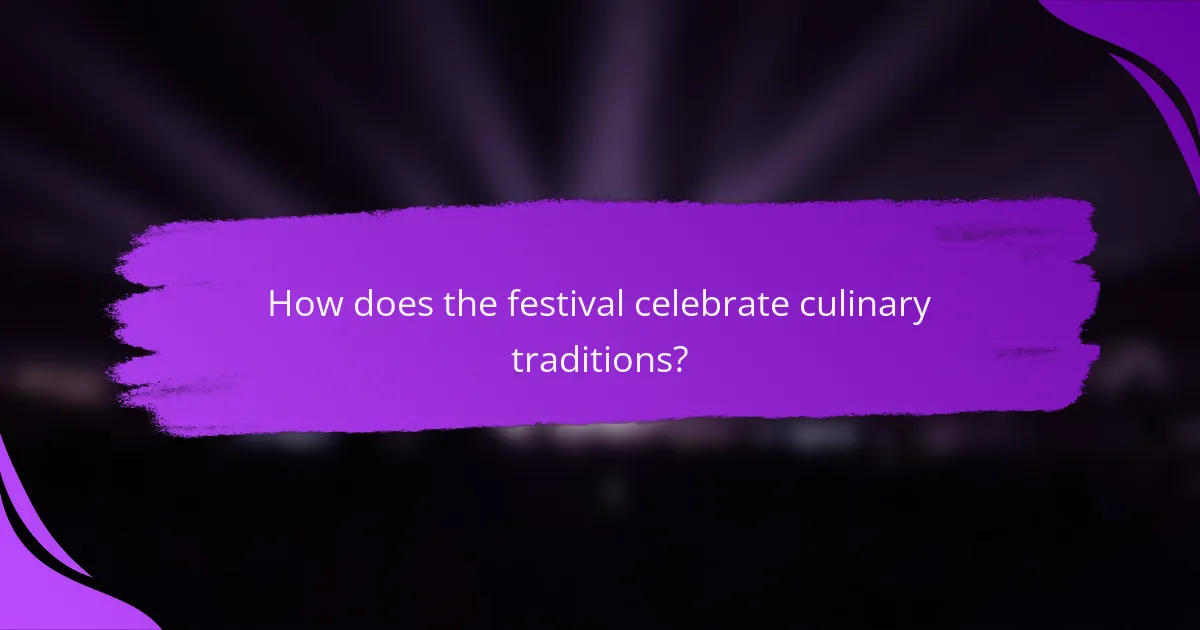
How does the festival celebrate culinary traditions?
The festival celebrates culinary traditions through diverse food offerings and local cuisine. Chefs and vendors showcase traditional dishes that reflect the region’s cultural heritage. Signature foods include gumbo, jambalaya, and po’boys. The event features cooking demonstrations by renowned chefs. Attendees can participate in tastings and culinary workshops. Local ingredients are prominently used in all dishes. The festival promotes the cultural significance of food in community bonding. This approach honors the culinary history of New Orleans while engaging visitors in its rich traditions.
What types of cuisine are represented at the festival?
The festival features a diverse array of cuisines. Represented cuisines include Creole, Cajun, and Southern barbecue. Additionally, there are offerings of seafood dishes and traditional New Orleans gumbo. The festival also showcases international flavors, such as Caribbean and African influences. Local vendors provide authentic dishes that reflect the city’s rich culinary heritage. This variety highlights the cultural significance of food in New Orleans. Each cuisine contributes to the overall festival experience, celebrating the city’s unique identity.
How do local chefs showcase their culinary skills during the event?
Local chefs showcase their culinary skills during the event through live cooking demonstrations and tastings. They prepare traditional dishes that reflect the rich culinary heritage of New Orleans. Chefs often use local ingredients to highlight regional flavors. Many chefs engage with attendees, sharing cooking tips and stories behind their recipes. The event features chef competitions that allow chefs to display their creativity and technique. Attendees can sample a variety of dishes, enhancing their culinary experience. This interactive approach fosters community engagement and appreciation for local cuisine. Overall, the event serves as a platform for chefs to celebrate and promote their culinary artistry.
What role does food play in enhancing the festival experience?
Food plays a crucial role in enhancing the festival experience by providing cultural context and community engagement. At the New Orleans Jazz & Heritage Festival, food reflects the region’s rich culinary heritage. Local dishes, such as gumbo and jambalaya, create a sense of place and identity. The festival features numerous food vendors, showcasing diverse cuisines that celebrate local traditions. This culinary variety attracts attendees and encourages social interaction. Sharing meals fosters connections among festival-goers, enhancing the overall atmosphere. Additionally, food experiences complement the musical performances, making the festival more immersive. The integration of food and music creates a holistic cultural celebration, enriching the festival experience for all.
How does the festival contribute to the local economy?
The festival significantly contributes to the local economy through increased tourism and local spending. It attracts over 400,000 attendees each year. Many visitors spend money on accommodations, dining, and local attractions. The festival generates approximately $300 million in economic impact annually. Local businesses, including hotels and restaurants, benefit from the influx of visitors. Employment opportunities also increase during the festival, providing temporary jobs. Additionally, the festival promotes local artisans and vendors, boosting their sales. Overall, the festival serves as a vital economic driver for New Orleans.
What economic impact does the festival have on local businesses?
The festival significantly boosts local businesses by increasing foot traffic and sales. Restaurants, hotels, and shops experience heightened demand during the event. Reports indicate that local businesses can see revenue increases of up to 30% during the festival. The influx of visitors contributes to job creation in the hospitality sector. Additionally, vendors at the festival benefit from direct sales to attendees. Local artisans and craftspeople gain exposure and sales opportunities. The overall economic impact can reach millions of dollars for the city. This financial boost supports community development and cultural preservation efforts.
How does tourism influence the festival’s growth?
Tourism significantly influences the growth of the New Orleans Jazz & Heritage Festival. Increased visitor attendance boosts ticket sales and revenue. This financial support allows for expanded programming and artist bookings. Tourism also enhances the festival’s visibility and reputation. As more tourists attend, the festival attracts higher-profile performers. Local businesses benefit from the influx of visitors, creating a supportive economic environment. This symbiotic relationship fosters community engagement and investment in festival infrastructure. Ultimately, tourism drives the festival’s evolution and sustainability.
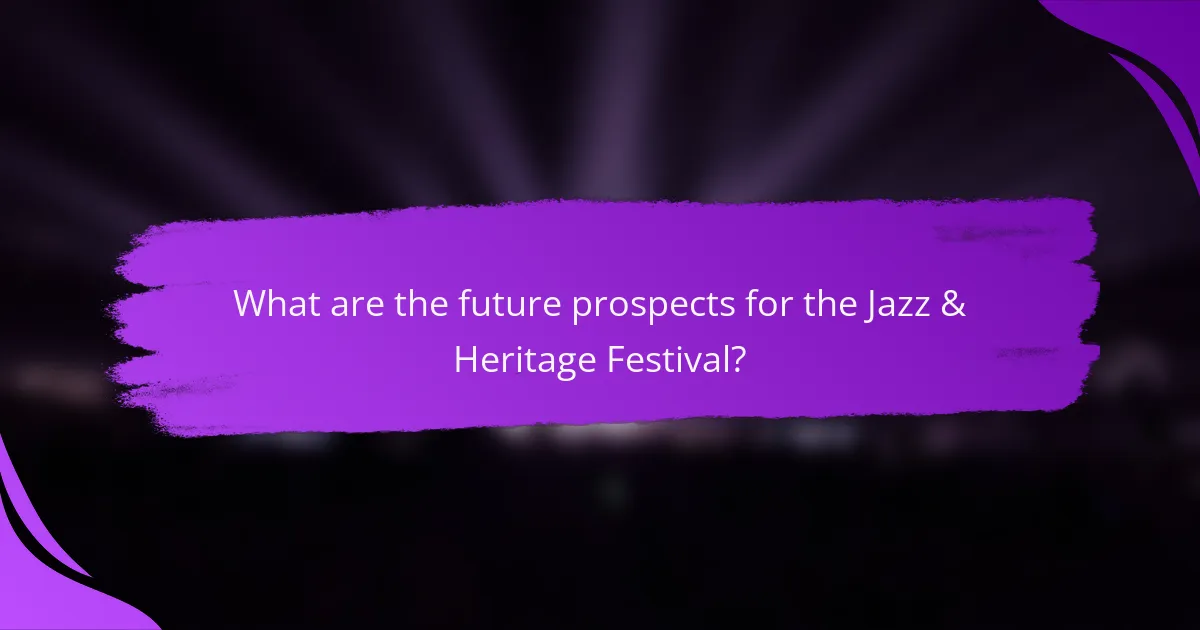
What are the future prospects for the Jazz & Heritage Festival?
The future prospects for the Jazz & Heritage Festival appear positive. The festival has a strong legacy, celebrating New Orleans’ musical and cultural heritage. Attendance has consistently grown, with over 400,000 visitors in recent years. The festival continues to attract diverse artists, enhancing its appeal. Community engagement initiatives are expanding, fostering local talent and participation. Sponsorship and partnerships are increasing, providing financial stability. The festival’s adaptability to trends, such as virtual events, indicates resilience. Ongoing support from local government and cultural organizations further ensures its future success.
How is the festival adapting to modern challenges?
The festival is adapting to modern challenges by integrating technology and enhancing accessibility. It has implemented online ticketing to streamline the purchasing process. This reduces long lines and increases convenience for attendees. The festival has also expanded its digital presence through social media engagement. This helps in reaching a broader audience and promoting events. Additionally, it has introduced virtual components to allow remote participation. This adaptation ensures inclusivity for those unable to attend in person. The festival continues to prioritize sustainability initiatives, reducing its environmental impact. These measures reflect a commitment to evolving with contemporary societal needs.
What innovations are being introduced to enhance the festival experience?
Innovations enhancing the festival experience include the integration of advanced technology and sustainable practices. Mobile apps provide real-time updates on performances and activities. Virtual reality experiences allow attendees to immerse themselves in the festival’s history. Cashless payment systems streamline transactions at food and merchandise stalls. Eco-friendly initiatives, such as recycling and composting, reduce environmental impact. Enhanced accessibility features ensure inclusivity for all attendees. Live streaming of performances expands audience reach beyond the festival grounds. These innovations aim to create a more engaging, efficient, and environmentally responsible festival experience.
How can attendees support the festival’s sustainability efforts?
Attendees can support the festival’s sustainability efforts by using public transportation or carpooling. This reduces carbon emissions associated with travel. Attendees should also bring reusable water bottles. This practice minimizes plastic waste generated at the event. Additionally, attendees can participate in recycling and composting initiatives provided at the festival. Engaging in these activities helps divert waste from landfills. Furthermore, purchasing local food and products supports sustainable practices within the community. Supporting local vendors reduces the carbon footprint related to food transportation. Lastly, attendees can volunteer for sustainability programs during the festival. This involvement promotes awareness and education about sustainable practices.
What can visitors expect when attending the festival?
Visitors can expect a vibrant celebration of music, culture, and community at the festival. The event features a diverse lineup of musical performances, showcasing local and national artists. Attendees can enjoy various genres, including jazz, blues, and gospel. Culinary offerings highlight New Orleans’ rich food traditions, with numerous food vendors serving authentic dishes. The festival also includes art exhibits that reflect the cultural heritage of the region. Workshops and discussions provide opportunities for community engagement and education. Overall, the festival fosters a sense of unity and celebration among attendees.
What tips can enhance the overall festival experience?
Plan ahead by reviewing the festival schedule. This ensures you prioritize must-see performances and events. Arrive early to secure a good spot for shows. This allows for a more enjoyable viewing experience. Stay hydrated and wear comfortable clothing. Festivals can be long and physically demanding. Explore diverse food options available at the festival. This enhances the culinary celebration aspect of the event. Engage with local artisans and vendors. Supporting them enriches the community engagement experience. Lastly, connect with fellow attendees. This fosters a sense of community and shared enjoyment.
How can attendees engage with the festival’s community and culture?
Attendees can engage with the festival’s community and culture through interactive activities and local participation. They can join workshops that showcase traditional crafts and music. Volunteers have opportunities to assist in various festival operations. Attendees can also participate in discussions and panels featuring local artists and cultural leaders. Engaging with local food vendors connects attendees to the culinary heritage of New Orleans. Social media platforms allow attendees to share their experiences and connect with others. Additionally, attendees can explore cultural exhibits that highlight the history and significance of jazz. These activities foster a deeper understanding of the festival’s cultural roots and community spirit.
The main entity of the article is the New Orleans Jazz & Heritage Festival, which highlights the city’s musical roots, community engagement, and culinary traditions. The festival celebrates diverse genres such as jazz, blues, and gospel, while emphasizing the historical significance of African American culture in New Orleans. Key aspects include the festival’s origins, influential figures, the role of local musicians, and the impact on community pride and local economy. Additionally, the article discusses how the festival promotes local culture through music and cuisine, and outlines future prospects and sustainability efforts.
